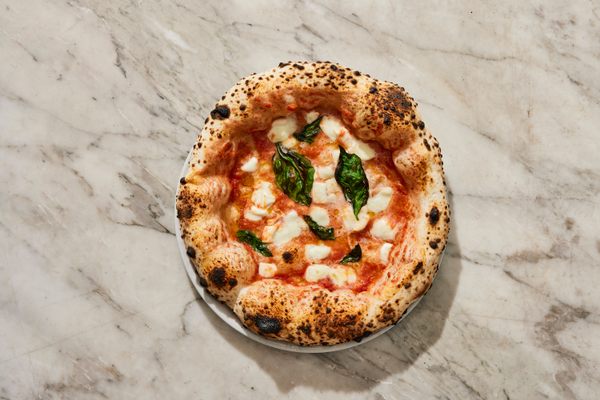Deciding who makes the best pizza in a city like New York is an inherently impossible task. But if you’re speaking strictly of Neapolitan-style pies—as opposed to Detroit-style squares, New York slices, Roman pizza al taglio, or Chicago’s towering amalgamations of sauce and cheese—you could make a strong case for Anthony Mangieri’s. Certainly, other people think so. The Italian organization 50 Top Pizza has named it the Best in the USA and even the Best in the World.
But regardless of how much stock you put in awards lists, these pies, with their puffy, leopard-spotted corniciones, speak for themselves. The dough varies every day, as Mangieri continues to tinker endlessly with proof times, hydration levels, and flours in the unending pursuit of perfection. A few truths remain consistent: the dough must be naturally leavened with a sourdough starter; the only ingredients are flour, water, salt, and time; and most importantly, every single pie must be made by Mangieri’s hands. If he’s sick, the Una Pizza Napoletana simply doesn’t open that day.
“More of my life has been spent making pizza than not,” says Anthony Mangieri, who estimates he made his first pie at age 13 in his home state of New Jersey. He spent much of his teenage years eating his way through the New York greats—Totonno’s, Lombardi’s, John’s on Bleeker—followed by the coal-fired classics in New Haven and finally the titans in Italy. “I’m 52 and 37 years of it was spent making pizza.”
While Una Pizza Napoletana is internationally known today, it was born as a ramshackle six-table operation just off of Point Pleasant Beach in the thick of the Jersey Shore. At the time, 25-year-old Mangieri was something of a one-man show. “I’d be making pizza, taking orders on the phone, and bringing people their pizza at the table while I’m still on the phone. It was nutty,” he recalls. Over time, the place built up a small community of regulars, some of whom would pitch in to help with dishes.
“My friends from the local tattoo shop would come and hang out and drink espressos, and people would be playing quarters in the back, gambling and smoking cigarettes,” he says. There was no website, let alone social media, so the whole operation was word-of-mouth for years. “It was a completely different era than the world now. But it was great.”
The sixth and current iteration of the restaurant is a tad more upscale, but the menu remains deliberately minimalist. There are no real sides or salads; just a handful of olives or roasted peppers for appetizers, plus a rotating gelato and sorbet as palate-cleansers. At any given time, there’s a half-dozen pizzas, each with a handful of ingredients. Diners can now add Calabrian hot peppers, anchovies, pepperoni, or 36-month-aged Parmigiano Reggiano, but the Margherita here requires none of these.
“Everything we add to the menu or take away from the menu is very purposeful,” Mangieri says. “I don’t like I don’t like clutter. I really love food that when you eat it, you’re like, ‘Oh, my God, every ingredient just made sense, and they all enhance the dish, and nothing was left to chance.’”

